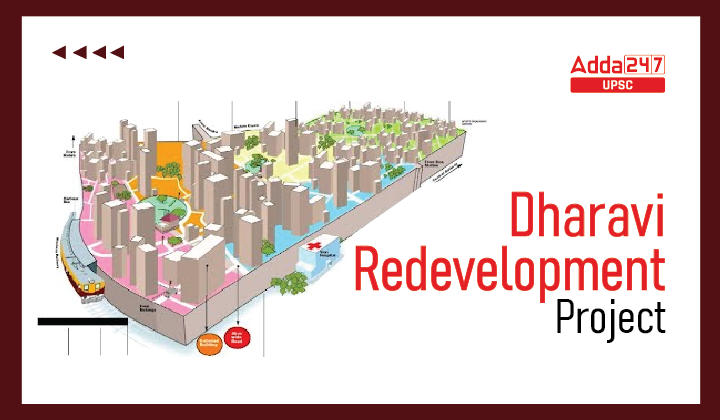Dharavi Redevelopment Project
Introduction
Dharavi, often referred to as Asia’s largest slum, is a sprawling urban settlement in the heart of Mumbai. It is home to over a million people and spans approximately 600 acres. Despite its notorious reputation for overcrowded and unhygienic conditions, Dharavi is also a thriving hub for small-scale industries, contributing nearly $1 billion annually through sectors like leather goods, pottery, textiles, and recycling. The Dharavi Redevelopment Project (DRP) is a transformative initiative aimed at reshaping this dense urban settlement into a sustainable, modern neighborhood while retaining its vibrant economic identity. This article will delve into the historical context of Dharavi, the current redevelopment plan, and the potential for a more sustainable and inclusive future.

Historical Context: From Salt Pans to Slum
Dharavi’s story begins in the 18th century as a cluster of salt pans. As Bombay (present-day Mumbai) grew, so did the demand for labor. Migrants from across India flocked to Dharavi, seeking work in the city’s burgeoning textile mills. By the mid-20th century, with mills shutting down, Dharavi became a center for small-scale industries like recycling, pottery, and leatherwork. However, proper infrastructure never kept pace with this growth, leading to overcrowding, inadequate sanitation, and limited access to basic services.
The Need for Redevelopment
Dharavi’s current state presents significant challenges for its residents, including a lack of clean water, sanitation, and basic amenities. The redevelopment project aims to address these issues by providing modern housing, improved infrastructure, and better living conditions for Dharavi’s residents. The project is not just about physical transformation but also about social and economic upliftment, ensuring that the residents are not displaced but rather integrated into the new development.
Current Redevelopment Plan
The Dharavi Redevelopment Project is a public-private partnership between the Maharashtra government and the Adani Group. The plan promises to transform Dharavi into a “world-class township” with a mix of residential, commercial, and open spaces. Residents who can prove occupancy before 2000 will be eligible for free flats of approximately 350 sq ft. The project boasts a high Floor Space Index (FSI) of over 4, allowing for high-rise buildings and increased commercial space.
Sustainable Design Principles for Dharavi
Sustainable Community-Driven Design
Resident participation throughout the planning process is crucial. This ensures the design caters to their needs and fosters a sense of ownership. Residents’ knowledge of local challenges and existing resource flows can inform decisions about waste management, water conservation, and energy efficiency.
Preserving the Informal Economy
Dharavi’s thriving recycling and small-scale industries are a testament to its resourcefulness. The redevelopment plan should integrate and support these businesses, not displace them. This could involve designated zones for workshops within the new development, incorporating features like shared co-working spaces and efficient waste collection systems.
Green Infrastructure
Creating green spaces like parks and community gardens not only enhances aesthetics but also improves air quality, reduces the heat island effect, and provides recreational areas. Utilizing rooftop gardens and vertical greenery on buildings can further maximize space and environmental benefits.
Renewable Energy and Energy Efficiency
The project should incorporate renewable energy sources like solar panels and wind turbines to reduce reliance on fossil fuels. Energy-efficient building materials and technologies like LED lighting and passive cooling techniques can minimize energy consumption and long-term operational costs.
Waste Management and Resource Recovery
Dharavi’s existing recycling industry demonstrates a strong foundation for a circular economy approach. The redevelopment plan can build upon this by designing waste management systems that promote composting, recycling, and upcycling. This not only reduces environmental impact but also creates potential livelihood opportunities in the waste management sector.
Sustainable Transportation
Encouraging walking, cycling, and public transportation use can significantly reduce traffic congestion and air pollution. Creating a network of pedestrian walkways, bicycle lanes, and well-connected public transport options can make car ownership less necessary.
The Adani Group’s Role in Sustainable Development
The Adani Group’s expertise can be crucial for implementing these sustainable design principles. The group should allocate resources for solar power installations, rainwater harvesting systems, and energy-efficient building materials. They should also partner with NGOs and training institutions to provide skill development programs and microfinance opportunities for residents to upgrade their businesses in the circular economy. Open communication about project details, financial projections, and profit-sharing mechanisms can build trust and ensure the project aligns with community needs.
Challenges and Considerations
The Dharavi Redevelopment Project faces multiple challenges, both at the ground and institutional levels. Addressing key issues is crucial for a just and efficient transformation. Some of the main challenges include ensuring equitable access to housing, infrastructure, and economic opportunities for all residents, regardless of socioeconomic background. Additionally, the project must balance the need for modernization with the preservation of Dharavi’s unique cultural and economic identity.
Conclusion
The Dharavi Redevelopment Project is a monumental effort to transform one of the world’s largest slums into a sustainable and inclusive urban neighborhood. While the project promises significant improvements in living conditions and infrastructure, it also faces numerous challenges that must be addressed to ensure its success. By prioritizing sustainable design principles, community engagement, and the preservation of Dharavi’s informal economy, the project has the potential to serve as a model for urban redevelopment initiatives worldwide.
External Links
For more detailed information on the Dharavi Redevelopment Project, please refer to the following links:
